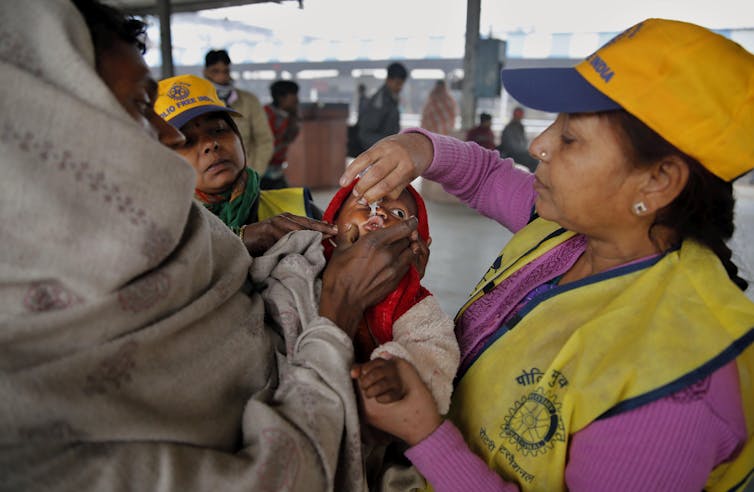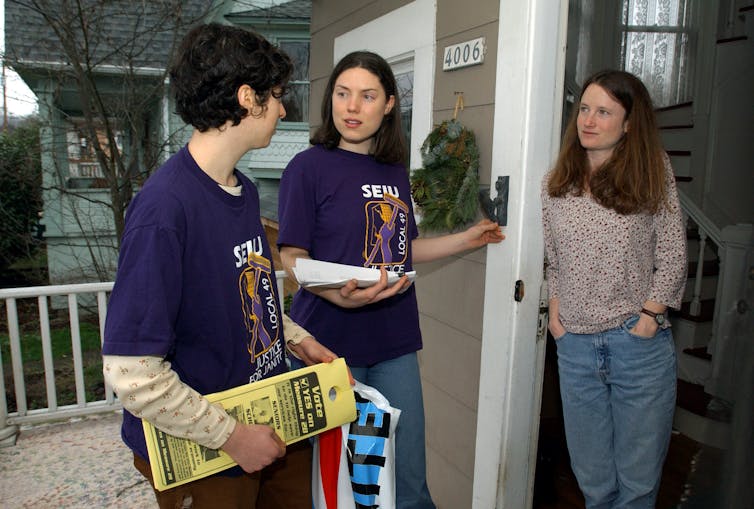
Misinformation about scientific topics, including falsehoods such as vaccines cause autism and climate change being an entirely natural phenomenon, is an issue scientists have been discussing more and more. Widespread misinformation can lead to confusion about public health and environmental issues and can hinder those working to solve societal problems.
As an environmental social scientist who researches how science can have an impact on society, I seek effective ways to address misinformation.
There are many approaches that can work to some extent: for example, counteracting erroneous information with statements about scientific topics based on quality research that convey that the majority of experts agree, and “inoculating” people by preparing them to spot the fallacies in misinformation before they are first exposed to it.
But one of the most important ways to counteract misinformation is less about the facts and more about how those facts move within social networks and communities. In other words, it’s not enough for science to be right – it has to be accepted within people’s social circles to have any meaningful impact.
Can facts change minds?
Most people tend to assume that their knowledge and ideas are based on a rational, objective analysis of information. And that’s sometimes the case – if it’s snowing outside, people don’t insist that it’s sunny and warm, no matter how much they might like it to be.
Similarly, if a person comes across some novel fact in the news, such as the discovery of a new type of plant in the Amazon, they might just absorb that information and go about their day.
But rationality and the ability to embrace new information goes out the window when it comes up against ideas that challenge one’s preexisting worldviews or social identities. Such information can feel like a personal attack, leading the body to release cortisol, a hormone associated with stress. So, certain facts can feel threatening or offensive.
Sometimes, people accept new information without much thought. But when new information challenges their existing beliefs, they may double down on their point of view.
Compounding what is happening in the brain is what’s happening in people’s communities. Humans are social animals who turn to others they trust to help them understand what’s what. People are attuned to what is considered normal or acceptable in their social environments, so if their social group holds a particular belief, they are more likely to adopt that belief too.
One’s cultural and political identities often dictate how they interpret the same information, leading to disagreements even when presented with the same evidence.
These cultural identities explain why, for example, research finds that science-skeptical behaviors, such as vaccine hesitancy and climate denialism, tend to cluster in social and geographical pockets. In these pockets, people’s scepticism is reinforced by others with similar beliefs in their social network. In such cases, providing more evidence on a certain topic won’t help, and it may even result in people digging in their heels deeper to deny the evidence.
So if facts don’t necessarily change minds, what will?
Leveraging community networks
Recent research provides a solution for scientists and agencies hoping to correct misinformation: Rather than fighting against humans’ social nature, work with it.
When people see trusted individuals within their social networks holding a certain belief, that belief becomes more credible and easier to adopt. Leveraging those community connections can allow new ideas to gain traction.
One great example of using social networks to fight misinformation is how polio was eradicated in India. In 2009, India was the polio epicentre of the world, home to half of the world’s cases. These cases were largely clustered in vaccine-hesitant regions of the country. But by 2011, only two years later, India had only one case, and the country formally celebrated the eradication of polio in 2014.
How did India go from having half of the world’s cases to just one case in under two years?
Public health agencies asked volunteers from within vaccine-resistant communities to go on a listening campaign and become ambassadors for the vaccine. The volunteers were trained in interpersonal communication skills and tasked with spending time with parents. They built trust and rapport through regular visits.
Because the volunteers were known within the communities, they were able to make headway where health workers from urban areas had not. As they established rapport, hesitant parents shared their concerns, which typically went beyond polio to include other health issues.
Over time, more and more parents decided to vaccinate their children, until there was a tipping point and vaccination became a social norm. Perhaps most notably, the campaign led to full routine immunisation rates in some high-risk regions of the country.
A medical volunteer administers polio immunisation drops to a child in India, years after the country’s last reported polio case. AP Photo/Rajesh Kumar Singh
India’s incredible success emphasises the importance of personal interactions for changing minds, which means moving beyond simply presenting the facts. Building trust, listening to concerns and engaging with communities in a meaningful way were integral to India’s eradication of polio.
The power of conversations
Another example of using the power of social networks to talk about controversial science topics comes from a method called deep canvassing. Deep canvassing is a unique communication method that involves going door to door to have conversations with members of the public.
But unlike traditional canvassing, which often focuses on rallying existing supporters, deep canvassing deliberately seeks to engage with those who hold different viewpoints, focusing efforts in communities where the topic is controversial.
In deep canvassing, canvassers seek to have longer and more in-depth conversations, to share perspectives and relate with the residents they’re visiting. AP Photo/Greg Wahl-Stephens
Canvassers are trained to ask questions to better understand the other person’s experiences and perspectives on the issue, and then they share their own personal stories. This helps to create a human connection, where both parties feel heard and respected. This connection can help to reduce the negative emotions that may emerge when someone is challenged to rethink their beliefs.
One notable example of deep canvassing in action is the work of Neighbours United, an environmental nonprofit in Canada. They used a deep-canvassing approach to engage people in conversations about climate change.
They piloted the method in a rural, conservative community called Trail, home to one of the largest zinc and lead smelters in the world. Prior efforts to engage community members hadn’t had much of an effect, as taking action on climate change was largely seen as being in conflict with how many people made their living.
But the deep-canvassing method worked. Going door to door, the canvassers listened to residents’ concerns, shared their own stories about the impact of climate change and highlighted local environmental successes.
As a result, 1 in 3 residents shifted their views about the importance of taking action to address climate change. This broad community support led the City Council to vote to transition to 100% renewable energy by 2050.
Sociologist Anthony Giddens described interpersonal interactions between experts, such as doctors or scientists, and the public as access points. He argued that these points are vital for maintaining trust in governmental and scientific institutions, such as the Centres for Disease Control and Prevention or the Environmental Protection Agency.
These face-to-face interactions with experts can help people see them as kind, warm and professional, which can lead to trust.
These examples show that creating support for attitudes and behaviors based on science requires more than just presenting facts. It requires creating meaningful dialogue between skeptical groups and scientific messengers. It’s also a reminder that while social networks may serve to propagate misinformation, they can also be an important tool for addressing it.![]()
*Anne Toomey, Associate Professor of Environmental Studies and Science, Pace University.
This article is republished from The Conversation under a Creative Commons license. Read the original article.
24 Comments
This is so critical, but I worry in the age of everyone having social media in their pocket, maybe impossible.
First we'd need to get rid of the bad actors intentionally doing the reverse of what is proposed here.
Censorship is the direct opposite of what is proposed in the article.
I think the perception matters. For many, the perception is that people who accept, for example, that "climate change is human-induced, and urgent" and "vaccines do not cause autism" are not open to criticism. Ironically, it appears that these people are ignorant and close-minded. Ordinary people do not arrive at such conclusions by reading lists of "facts" from scientific journals and meta analyses. Rather, they get it second-, third- or fourth-hand from chains of fallible friends and family members, and such people typically don't actually understand why they believe what they believe, they just trust authority figures. A culture of good faith debate is what will convince people to change their minds. I well remember over a decade ago when Stuff decided it would no longer allow comments on articles about climate change, as it was concerned that people would make comments arguing against the "settled science". I would argue that is absolutely the wrong decision. We see similar stifling of debate on university campuses today. Not being (or merely not appearing to be) open to critique makes you a dogmatist, even when you're right.
I absolutely agree. Free debate will encourage people to have some trust. On some issues there seems to be very little public scientific debate – whether it is human induced climate change or C-19 vaccine safety. Science is rarely settled, new observations and studies provide more information. Typically vaccines are tested for 5-7 years before they are released to vaccination programmes.
This article reeks of ‘how do we better convince the public next time’. Meanwhile a significant portion of the public are asking why was Dr Anthony Fauci offered a pre-emptive pardon by President Biden and why did Dr Fauci accept it? Perception does indeed matter.
Yeah, these guys should have been shut down immediately. We had to spend about $100 billion to counter this
dis/mis/mal/take-your-pick information.
"Dr Ashley Bloomfield explains. "They're not very effective, after all the virus can also infect you via your eyes - it basically likes to land on mucus membranes - from your eyes it likes to go down your nose anyway - so I think people should not bother with facemasks," he says."
https://www.1news.co.nz/2020/02/29/face-masks-fly-off-shelves-as-worrie…
PM: Yeah. So, of course, what Professor Hendy has talked about here is the importance of us having good, high rates across the board, because what we know is that Delta will be very good at finding unvaccinated people, and if there’s a pocket of unvaccinated people—and that includes an age group or an entire community or town. If it finds those pockets, that’s where you’ll have outbreaks. So that’s why it’s important we have really good spread across New Zealand, across ages, across towns and cities, across ethnicities, because that will help break those chains of transmission."
https://www.beehive.govt.nz/sites/default/files/2021-09/Press%20Confere…
Nah. All science has to be is right. Or at least as right as it can possibly be. If people choose not to agree with science that isn’t the fault of science.
The best thing for the integrity of any non political endeavour is to avoid politics. Half the population may not believe you if you tie your flag to politics.
How do we counter funded disinformation like Fox News ? Those that deliberately lie to make money ?
We can't, and we haven't.
They have Bernays, logarithms, a compliant media and money.
We have truth.
They win - until they don't, because the truth kills their oh-so-necessary GROWTH. Which is happening now...
“The Party told you to reject the evidence of your eyes and ears. It was their final, most essential command”
Recently posted, bears repeating.
So believe Trump, Joe Rogan, RFK,Putin, Musk,Goebbels etc
Also
Doublethink is a process of indoctrination in which subjects are expected to simultaneously accept two conflicting beliefs as truth, often at odds with their own memory or sense of reality. Doublethink is related to, but differs from, hypocrisy.
Men in general are quick to believe that which they wish to be true.
Biden, Ardern, Albanese, Trudeau….
BBC, Guardian, CNN, ABC ( Aussie and US) etc
Sounds like you don't trust MSM but trust sites riddled with disinformation, maybe you are a conspiracy theorist??
lol wut, will you send me to a re- education camp Commisar
Bit ironic that your first quote is Orwell, who was a socialist until he realised how morally bankrupt they were.
Are you able to provide a reference for a lie from Fox News?
I’ll take that as a no. Ironically I could, because I actually read it, Try to be open minded.
I am not a psychologist but have read widely on the subject- Kahneman and Tversky, Ariely, Dobelli and others and I believe that confirmation bias affects all of us. we all come to believe in certain things whether that be to with religion, politics, vaccines etc and we find it difficult to consider information that might throw doubt on these beliefs. That's just human nature.
.
Human nature that can be changed by experience. If you are a computer programmer you have frequent reminders that you are fallible; same applies to engineers and chess players. Continual evidence of our regularly mistakes tends to make you scientific - i.e. be sceptical.
The evidence I've read persuades me to believe governments should be tackling climate change. However if I query the number of polar bears who were supposed to be extinct or the frequency of hurricanes hitting the gulf of Mexico (is that name right?) or the extent of past forest fires in California and Australia then I'm treated as a climate change denier. I want to see less CO2 in the atmosphere and my country doing more than its share tackling this world wide problem but the media's reporting, the bureaucracy and politics involved repels me.
What an irritating article. The word science has respect so there is Scientology and Christian Science and 'social science'. Just include science to the name to give it credibility - it used to be 'by royal decree' that added kudos but now it is science. This article is about two examples of successful public relations; not science. Even debatable if those Canadians producing the zinc and lead the world depends on (well at least the world that has electricity and access to the internet) are now feeling guilt and shame. Similar to NZ dairy farmers - evil people being our main cause of global warming.
The phrase 'science-skeptical behaviors' misses the point. All science is skeptical, it prefixes every statement with "I may be wrong but .....". This is the opposite of the positive convictions of the religious. It is the absence of skepticism that kills science. There are examples in the other comments. Kiwis are now less trusting of health authorities simply because those authorities would not accept any criticism in the recent past.
Only the Machiavellian and simple insist science to be the ultimate permanent truth.
True. You cannot let science rule everything. For example consider those Indians who didn't catch polio because of the successful promotion of vaccines. That was public relations producing a good result. To be real social 'science' they would have applied the public relations exercise to some villages and not others and then measured how many children caught polio. Good science but bad morality. They tried a method for changing public opinion and if it hadn't worked they would have tried another - that's common sense but not science.
That doesn’t make any sense. Science is a human endeavour undertaken in the attempt to find the ultimate truth.
It can never be the ‘ultimate and permanent truth’.
Lol.... Pluto is a Planet, The World is Flat....
Knowledge evolves, or more accurately our understanding and acceptance of it changes...



We welcome your comments below. If you are not already registered, please register to comment.
Remember we welcome robust, respectful and insightful debate. We don't welcome abusive or defamatory comments and will de-register those repeatedly making such comments. Our current comment policy is here.